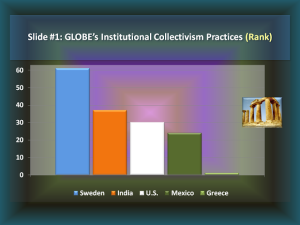Culture is defined as the learned beliefs, values, rules, norms, symbols and traditions that are common to a group of people.
Cluster is a system used to identify the clusters of world cultures; it is being used by the GLOBE researchers. They divided the data from the 62 countries they studied into regional clusters. These clusters provide a convenient way to analyze the similarities and differences between culture and leadership. To create regional clusters, GLOBE researchers used prior research, common language, geography, religion and historical accounts.
Based on these factors, they grouped the countries into 10 distinct clusters. Namely;
1- Anglo
2- Latin Europe
3- Nordic Europe
4- Germanic Europe
5- Eastern Europe
6- Latin America
7- Middle East
8- Sub-Saharan Africa
9- Southern Asia
10- Confucian Asia
Clusters provide a convenient way to:
- Analyze similarities and differences between cultural groups

- Make meaningful generalizations about culture and leadership
To test whether the clusters or groups of countries were valid researchers did a statistical analysis of questionnaire data collection from individuals in each of the clusters. From the findings which they got through the data collected they concluded that each cluster was unique.
GLOBE research analyzed data on each of the regions using the dimensions of culture. Results found regional clusters that were significantly higher or lower on particular dimensions
Characteristics of clusters:
| Distinct | Characteristics |
| Anglo | Competitive and result-oriented |
| Confucian Asia | Result-driven, encourage group working together over individual goals |
| Eastern Europe | Forceful, supportive of co-workers, treat women with equality |
| Germanic Europe | Value competition & aggressiveness and are more result-oriented |
| Latin America | Loyal & devoted to their families and similar groups` |
| Latin Europe | Value individual autonomy |
| Middle East | Devoted & loyal to their own person, women afforded less status |
| Nordic Europe | High priority on long-term success, women treated with greater equality |
| Southern Asia | Strong family & deep concern for their communities |
| Sub-Sahara Africa | Concerned & sensitive to others, demonstrate strong family loyalty |
Leadership behavior and culture cluster
The overall purpose of the GLOBE project was to determine how people from different cultures viewed leadership. In addition, researchers wanted to determine the ways in which cultural characteristics were related to culturally endorsed leadership behaviors. In short, they wanted to find out how differences in cultures were related to differences in approaches to leadership.
The conceptualization of leadership used by GLOBE researchers was derived in part from the work of Lord and Maher (1991) on implicit leadership theory. According to implicit leadership theory, individuals have implicit beliefs and convictions about the attributes and beliefs that distinguish leaders from non-leaders and effective leaders from ineffective leaders. From the perspective of this theory, leadership is in the eye of the beholder (Dorfman, Hanges, & Brodbeck, 2004). Leadership refers to what people see in others when they are exhibiting leadership behaviors.
To describe how different cultures view leadership behaviors in others, GLOBE researchers identified six global leadership behaviors: charismatic/value based, team oriented, participative, humane oriented, autonomous, and self-protective (House & Javidan, 2004). These global leadership behaviors were defined in these studies as follows:
1- Charismatic/value-based leadership reflects the ability to inspire, to motivate, and to expect high performance from others based on strongly held core values. This kind of leadership includes being visionary, inspirational, self-sacrificing, trustworthy, decisive, and performance oriented.
2- Team-oriented leadership emphasizes team building and a common purpose among team members. This kind of leadership includes being collaborative, integrative, diplomatic, no malevolent, and administratively competent.
3- Participative leadershipreflects the degree to which leaders involve others in making and implementing decisions. It includes being participative and no autocratic.
4- Humane-oriented leadershipemphasizes being supportive, considerate, compassionate, and generous. This type of leadership includes modesty and sensitivity to people.
5- Autonomous leadershiprefers to independent and individualistic leadership, which includes being autonomous and unique.
6- Self-protective leadershipreflects behaviors that ensure the safety and security of the leader and the group. It includes leadership that is self-centered, status conscious, conflict inducing, face saving, and procedural.
These six global leadership behaviors emerged from the GLOBE research and were used to assess the different ways in which various cultural clusters viewed leadership. From this analysis they were able to identify a leadership profile for each cluster. Each profile describes the relative importance and desirability that different cultures ascribe to different leadership behaviors.














